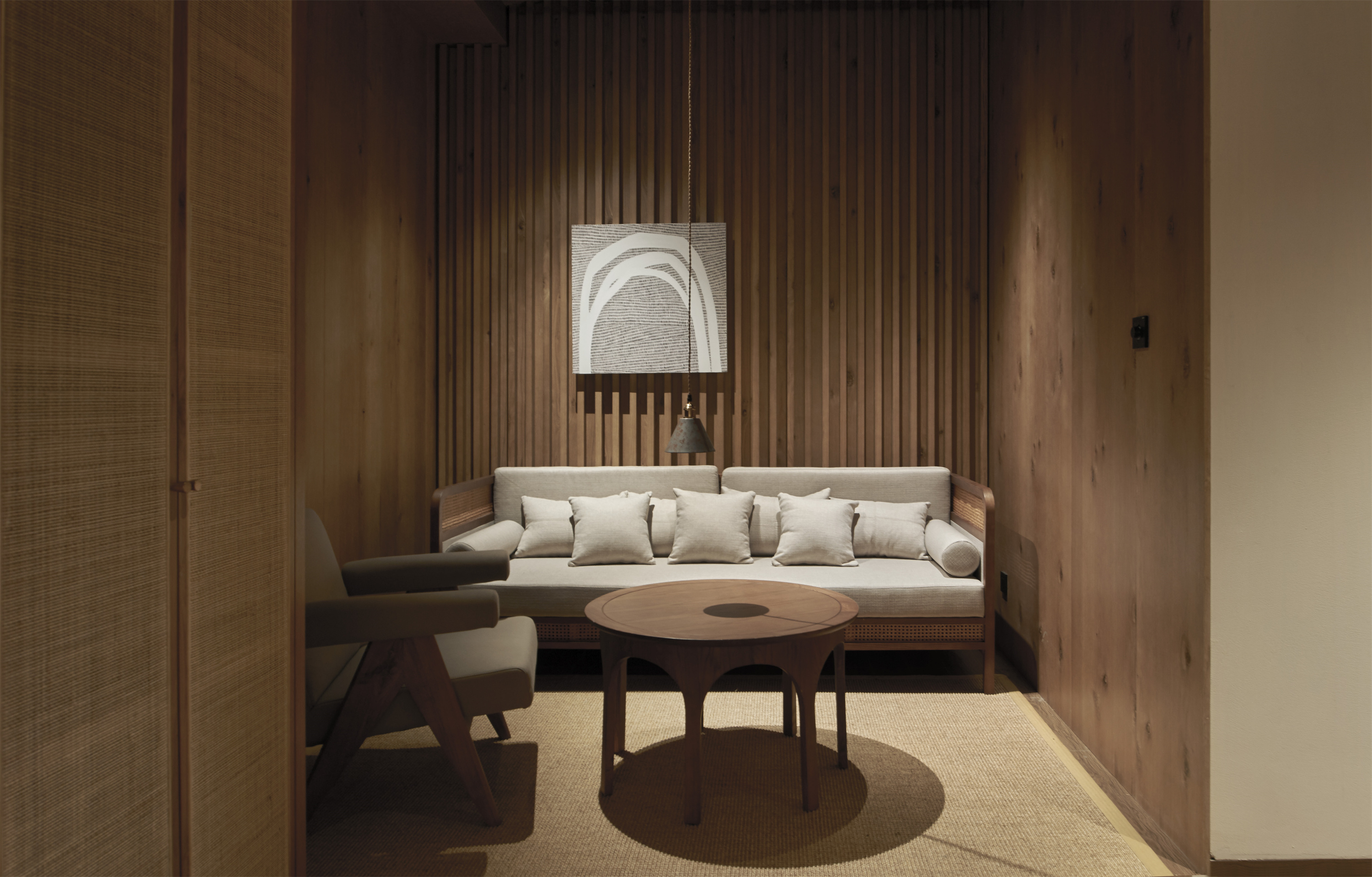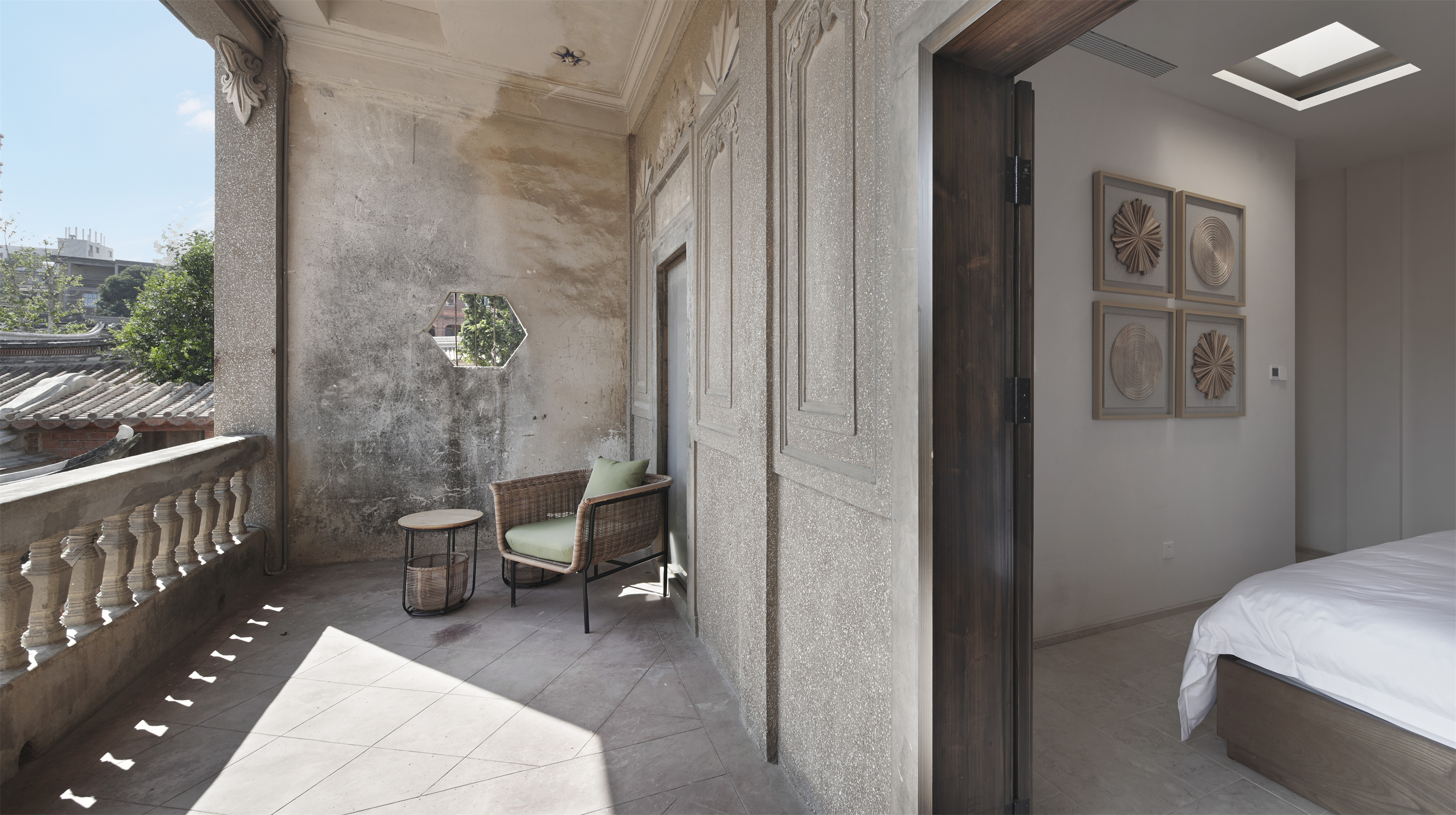
设计单位 谜舍设计工作室
项目地点 福建晋江
建成时间 2021年6月
建筑面积 6400平方米
本文文字由设计单位提供。
青普梧林文化行馆位于福建省晋江市梧林古村落,场地面积约6000平方米,由13栋福建传统民宅组成。谜舍设计受到青普TSINGPU的委托,主持整体项目,将这个古建筑群落设计改造成客房、餐厅、茶馆、展览、论坛等兼具多元业态的文化旅游度假目的地。
Tsingpu Wulin Retreat is located in the ancient village of Wulin, Jinjiang City, Fujian Province, with a site area of about 6,000 square meters, consisting of 13 traditional houses of Fujian. Entrusted by the famous cultural resort group TSINGPU, we presided over the design and transformation of this ancient building community into a multi-business cultural tourism resort destination with guest rooms, restaurants, teahouses, exhibitions, forums, etc.


场地的建筑分为闽南红砖古厝以及南洋楼两种主要风格。形态迥异的建筑彼此呼应,创造丰富的场所体验。我们希望保留这样自然原始的美感,并以较为谨慎的手法处理整体的空间,尽可能地避免过度设计;在充分尊重地域建筑文化的同时,结合符合现代审美的设计语言,打造出具有文化性及高品质度假感的“新闽南空间形态”。
The buildings of the site are divided into two main styles: the old red brick house in southern Fujian and the Nanyang building. The buildings of different shapes subtly echo each other, creating a very rich experience of architectural places. We hope to retain such natural and original beauty, and deal with the overall space design in a more cautious way and avoid excessive design as much as possible. While fully respecting the regional architectural culture, and combining with the modern aesthetic design language, the "New Southern Fujian Space Form" with cultural and high-quality sense of vacation is created.

接待空间
—
接待空间是客人对于行馆室内空间形态的初次认知。我们保留建筑的木结构,将划分房间的木质隔墙拆除;通过引入玻璃天窗、暗藏空调等方式,营造出明亮通透且具有室内舒适性的空间,让客人感知闽南古厝的魅力及新的可能性;使用夯土材料很好地呼应了传统建筑的历史感。
As the first cognitive space for a guest, we kept the reception space construction timber structure, dismantled divided the wooden partition wall of the room, and through the introduction of glass skylights, hidden air conditioning, and create a bright space with the indoor comfort, let a guest to perceive the charm of minnan historic house space and new possibilities. The use of rammed earth materials is a good echo of the historical sense of traditional architecture.


客房
—
闽南古厝风格客房
我们重新整理场地内每一栋闽南古厝的内部平面划分,做出更为放松宜人的空间格局;并将面向内庭的立面打开,用木格栅填充,使自然光线进入到客房的同时又有相对的隐私性。
We rearranged the internal division of each ancient house in southern Fujian of the site and made a more relaxed and pleasant spatial pattern. We opened the facade facing the inner courtyard and filled it with wooden grille, so that the natural light can enter the guest rooms while providing relative privacy.




客房内主要选用木质、涂料、草席等具有自然质感的材料。有时间肌理的闽南红砖墙、老木门等局部构件被有选择地保留下来,并与现代崭新的材料在同一空间中形成差异化美感,提升客房体验以及空间张力。
The rooms are mainly made of wood, paint, mat and other natural materials. The local components of the ancient building itself, such as the time-textured red brick wall of southern Fujian, the old wooden door and so on, have been retained selectively, and form an ingenious differentiated aesthetic feeling in the same space with the new modern materials, which greatly improves the guest room experience and spatial tension.





为保证客人居住在馆中的舒适度,每间古厝客房都设置空调和热水。我们通过精准的机电设计,将设备及管线隐藏在房间的吊顶及墙体内部,力求不破坏客房空间古朴的氛围。
In order to ensure the comfort of guests living in the ancient buildings, each ancient guest room is equipped with air conditioning and hot water. Through precise mechanical and electrical design, equipment and pipelines are well hidden inside the ceiling and wall of the space and try not to destroy the primitive atmosphere of the guest room space.



房间的隔墙做了隔音处理。我们与工人师傅排查梁柱交接处的空洞部分,保证客房具有良好的隔音。
The partition wall of the room has done a good sound insulation treatment. We carefully checked the hollow part at the junction of the beam and column with the workers at the site to ensure that the guest room has a good sound insulation.


古厝建筑的木窗被新的实木材料重新复刻,具有更好的使用性,同时,该做法还原了老窗富有特色的开启方式。
The wooden windows of the ancient buildings are re-carved with new wood materials, which not only has better usability, but also restores the characteristic opening way of the old windows.


我们非常关注传统建筑中设计客房的空间尺度。过高过矮的空间都会影响住宿的舒适度,因此我们谨慎地处理不同区域的标高,希望客人在客房中既能体验到闽南古厝高大的建筑形制,又能有不失近人尺度的亲切感。我们向业主建议,在每一间客房都设置黑胶唱机,梁柱中环绕着的音符会让传统建筑空间更加丰富立体。
We are very concerned about the spatial scale of guest rooms in traditional architecture. Both too high and too low space will affect the comfort of accommodation, so we carefully handle the height of different areas, hoping to retain the tall architectural form of the ancient house in southern Fujian, but not lose the sense of intimacy of the human scale. We suggested that each guest room should be equipped with a vinyl record player, and the music surrounding the beams and columns would make the traditional architectural space with a sense of history appear more rich.



对于部分较大的古厝两旁的护厝,我们通过封闭护厝天井使用的玻璃天窗,打造拥有自然光线的沐浴区域。
Some of the larger old houses are surrounded by guardhouse. We closed the patio of the house with glass. A bathing area with natural light is created in the relatively inward and closed ancient house in southern Fujian.



南洋风格客房
南洋风格建筑是场地中另一种类别的闽南建筑,我们希望做出与闽南古厝风格有差异的南洋感客房空间。
Nanyang style architecture is another type of Fujian architecture in the site. We hope to create room space with Nanyang sense that is different from the southern Fujian style.




南洋文化是包容、多元的文化,设计师试图通过设计将南洋文化的这一特质传递给房客。在空间语言上,我们刻意地避开传统南洋风格的典型符号,而是使用较为简约、但细部圆润处理的设计手法,营造一种具有包裹感的空间。软装风格较为多元,设计中融入大量色彩、花纹及自然元素。这样的软硬装风格搭配方式,包容性强却又轻松自在,是我们对于南洋文化的解读。
Nanyang culture is inclusive and diverse, and we try to convey this characteristic of Nanyang culture to the guests living in the guest rooms. In terms of space language, we deliberately avoid the typical symbols of traditional Nanyang style, instead, we use a simple but rounded design technique to create a space with a sense of inclusion. Soft outfit style is more diversified, into a large number of colors, patterns and natural elements. This kind of soft and hard outfit style collocation is our interpretation of Nanyang culture, which is inclusive but relaxed.




餐厅
—
餐厅是最具有社交属性的公共空间。我们使用了新的设计手法,演绎空间的结构及材料,希望打造一个开放明亮、具有现代空间体验的闽南古厝。
The restaurant is the most social public space. We used new design techniques to interpret the structure and materials of the space, hoping to create a very open and bright ancient house in southern Fujian with modern space experience.


茶馆
—
茶馆是连接行馆与行馆外的体验型空间,我们希望营造出层次丰富的空间氛围。一方面,我们保留完整的院落格局及建筑形制,让访客感受传统古厝的魅力;另一方面,我们通过立面打开、玻璃盒子置入等方式,创造具有多场景、沉浸感的新型茶饮空间体验。
The teahouse space is an experience-type space that connects the retreat and outside the retreat. We hope to create a spatial atmosphere with rich layers. On the one hand, we retain the complete courtyard pattern and architectural form of the ancient house, so that visitors can feel the charm of the traditional ancient house; On the other hand, we also created a new tea space experience with multiple scenes and immersion by opening the facade and inserting a glass box.



茶馆空间整体色调较为深沉,接近大地色,结合中古风格家具,呼应了闽南古厝的历史厚重感。
The overall tone of the teahouse space is relatively deep, close to the earth color, and the integration of the medieval style furniture with a sense of time echoes the sense of historical weight of the ancient house in southern Fujian.




完整项目信息
项目:青普梧林文化行馆
项目甲方策划:宫琳娜、田明、林炜城、贺亚东
面积:6400平方米
完工时间:2021年6月
设计公司:谜舍设计工作室
设计团队成员:田少寅、曾煜娴、李然、王思源、张瑞哲、张青
软装设计顾问:曾煜婷
景观顾问:览艺生态设计工作室(马越)
机电设计顾问:北京玖奕设计咨询有限公司(李勇,刘明杨,徐翔宇)
照明设计顾问:Ljus Design(石岡真己子)
主要材料及品牌:AICA涂料、Haro地板、费罗娜、本土创造
照片拍摄:北京锐景摄影(广松美佐江,宋昱明)
版权声明:本文由谜舍设计工作室授权发布。欢迎转发,禁止以有方编辑版本转载。
投稿邮箱:media@archiposition.com
上一篇:存在建筑×原画册:猎奇冲击vs.平实日常,我们需要怎样的建筑图像? | 有方讲座64场介绍
下一篇:Dezeen Awards 2022 开放报名